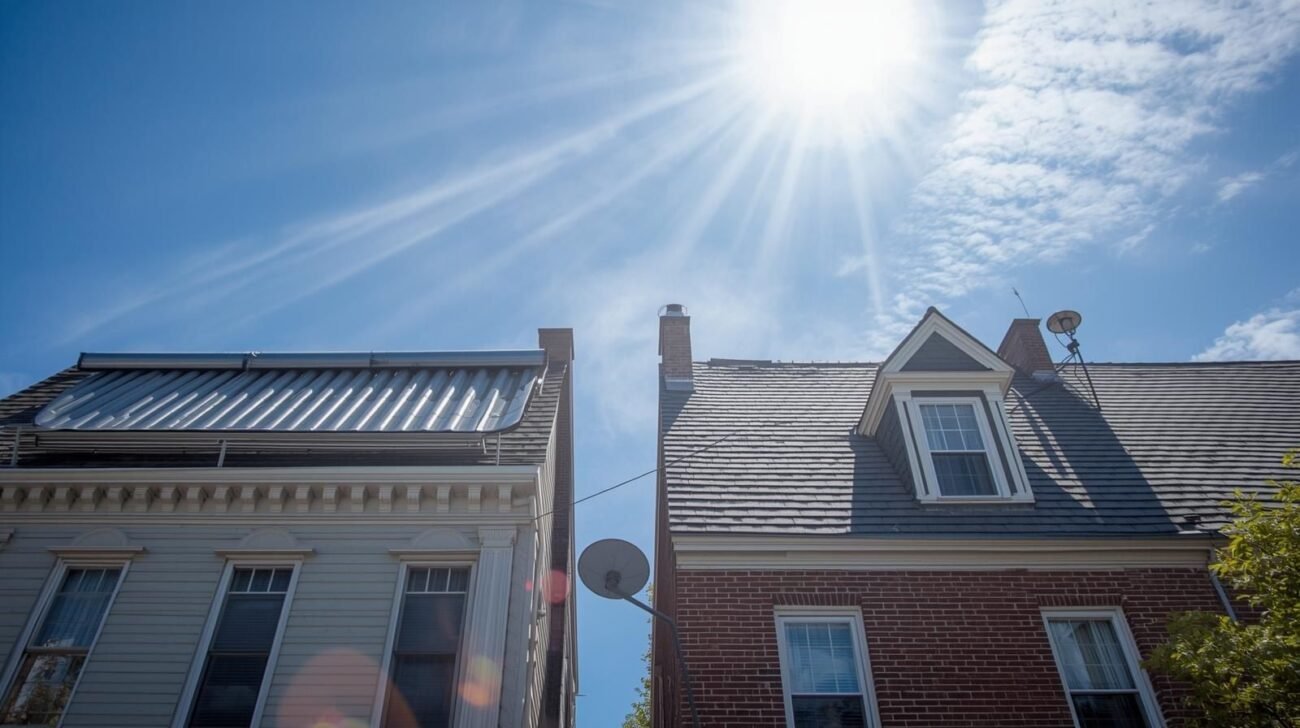
Are you deciding which roofing material is right for your Brooklyn home? With Brooklyn’s unpredictable weather, choosing between roll roofing vs asphalt shingles can feel like a challenge. Each option has its strengths, but how do you know which one will stand up to the city’s cold winters, humid summers, and occasional storms?
In this blog post, we’ll discuss key differences between roll roofing and asphalt shingles. We’ll explore how each performs in Brooklyn’s climate, comparing costs, durability, maintenance, and more. By the end, you’ll have a clear understanding of which roof type fits your home’s needs. Stay with us as we help you make an informed choice!
10 Most Key Differences: Roll Roofing vs Asphalt Shingles
Understanding the key differences between roll roofing and asphalt shingles is crucial when deciding which is best for your home in Brooklyn. These differences affect your roof’s performance, durability, and long-term costs. By knowing the variations, you can make an informed decision about the best roof for your specific needs. Let’s explore the most important distinctions to help you decide.
What Are the Differences in Structure and Materials?
The structure and materials of roll roofing and asphalt shingles determine how they perform under different weather conditions. Below, we’ll explore six key materials and design elements for each roofing type:
Roll Roofing:
- Bitumen-Based Material: Roll roofing typically uses a bitumen layer that provides waterproofing. This material is cost-effective and quick to install, making it ideal for flat roofs or small areas.
- Single-Layer Design: It’s a simple, single-layer material, which keeps the roof installation process fast and affordable. However, this design can lack the strength needed for high winds.
- Reinforced with Fiberglass: Some roll roofing uses fiberglass for added strength and durability. This reinforcement helps prevent the roof from tearing during harsh weather conditions.
- No Granules: Unlike asphalt shingles, roll roofing does not contain granules. This means it may not reflect heat as efficiently or protect against UV rays as well as shingles.
- Uses Asphalt as a Base: Roll roofing often uses asphalt as its base material, similar to asphalt shingles but without the granules for added protection.
- Limited Color Options: Roll roofing generally offers fewer color choices. Its simple, flat appearance makes it less appealing for homeowners who want a stylish roof.
Asphalt Shingles:
- Granulated Surface: Asphalt shingles have a granulated surface that provides a protective layer against UV rays and helps reflect heat. This feature can help improve the energy efficiency of your home.
- Multi-Layer Design: Asphalt shingles are often composed of multiple layers. These layers offer enhanced protection against the elements, thereby improving longevity and durability.
- Fiberglass or Organic Felt Base: The base material in asphalt shingles is either fiberglass or organic felt. Fiberglass shingles tend to be lighter and more fire-resistant.
- Variety of Styles and Colors: Asphalt shingles come in a wide range of colors and styles. This variety allows homeowners to choose a roof that complements their home’s design.
- Heavy-Duty Granules: The granules on asphalt shingles add to their durability and resistance to weathering. They help keep the shingles intact under extreme conditions.
- Longer Lifespan: Asphalt shingles are generally more durable, with a longer lifespan compared to roll roofing. They can handle harsher weather and more wear over time.
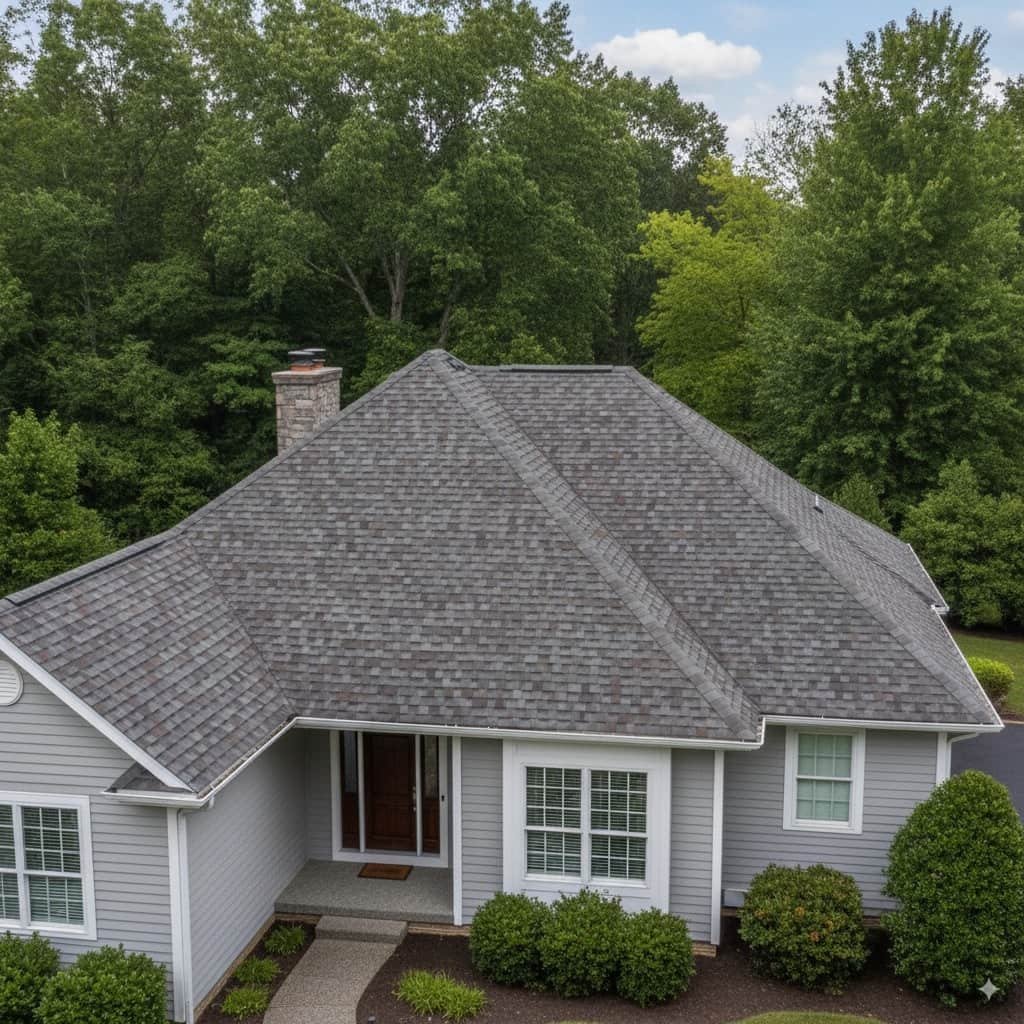
Durability and Longevity
When it comes to durability, asphalt shingles are better than roll roofing. Asphalt shingles typically last 20 to 30 years, which offers a longer lifespan due to their multi-layered design and granulated surface.
On the other hand, roll roofing tends to have a shorter lifespan of 10 to 15 years, primarily due to its simpler structure and single-layer design. For homeowners seeking long-term durability in Brooklyn’s weather, asphalt shingles provide better protection.
How Does the Installation Process Differ?
The installation process for roll roofing and asphalt shingles differs in terms of complexity, time, and materials used. Below is a comparison of the installation process for each:
| Installation Factor | Roll Roofing | Asphalt Shingles |
| Installation Time | Faster, usually completed in a day or two. | Takes longer, typically a few days depending on roof size. |
| Skill Level Required | Basic skills required for installation. | Requires professional skill to install properly. |
| Tools Needed | Simple tools, mainly for measuring and cutting. | Specialized tools needed for accurate shingle placement. |
| Roof Preparation | Minimal preparation, works on flat roofs. | Requires more preparation, especially for sloped roofs. |
| Material Handling | Rolls are easier to handle and transport. | Shingles are heavier and require more care during handling. |
| Installation Cost | Generally lower due to simpler installation. | Higher due to labor-intensive installation. |
| Weather Considerations | Best for mild weather conditions. | Suitable for all weather conditions, especially in areas with heavy snow or rain. |
How Does Cost Consideration Compare Between Roll Roofing vs Asphalt Shingles?
When comparing the cost of roll roofing and asphalt shingles, installation costs play a significant role. Roll roofing is often the more budget-friendly option. The cost ranges from $1.50 to $2.50 per square foot. On the other hand, asphalt shingles generally cost between $3.50 and $5.50 per square foot, due to their more complex installation process and higher material quality. While roll roofing offers an affordable initial cost, asphalt shingles provide greater value over time due to their durability and longer lifespan.
Roll Roofing Installation Cost
| Roll Roof type | Material Cost (per sq ft) | Labor Cost (per sq ft) | Total Cost (per sq ft) |
| Mineral-Surfaced Roll (MSR, nail-down) | $0.75 – $1.50 | $1.75 – $4.50 | $3.00 – $6.00 |
| Smooth Asphalt Roll + Reflective Coating | $0.75 – $1.50 | $1.75 – $4.50 | $3.00 – $6.00 |
| SBS Modified Bitumen (Self-Adhered, 2-ply) | $1.50 – $3.00 | $2.50 – $5.00 | $4.50 – $8.00 |
| APP Modified Bitumen (Torch-Down, 2-ply) | $1.50 – $3.00 | $2.00 – $4.00 | $3.50 – $7.00 |
| Cold-Adhered Modified Bitumen (2-ply) | $1.50 – $3.00 | $3.00 – $5.00 | $4.50 – $8.00 |
| Torch-Down Rolled Roofing (general range) | $1.80 – $3.50 | $3.00 – $5.00 | $4.80 – $8.50 |
Asphalt Shingles Installation Cost (per sq. ft.)
| Installation Type | Material Cost (per sq. ft.) | Labor Cost (per sq. ft.) | Total Cost (per sq. ft.) |
| Basic (3-tab shingles) | $1.50 – $2.50 | $1.50 – $2.50 | $3.00 – $5.00 |
| Mid-range (Architectural shingles) | $2.50 – $4.00 | $2.50 – $4.00 | $5.00 – $8.00 |
| Premium (Luxury shingles) | $4.00 – $6.00 | $4.00 – $6.00 | $8.00 – $12.00 |
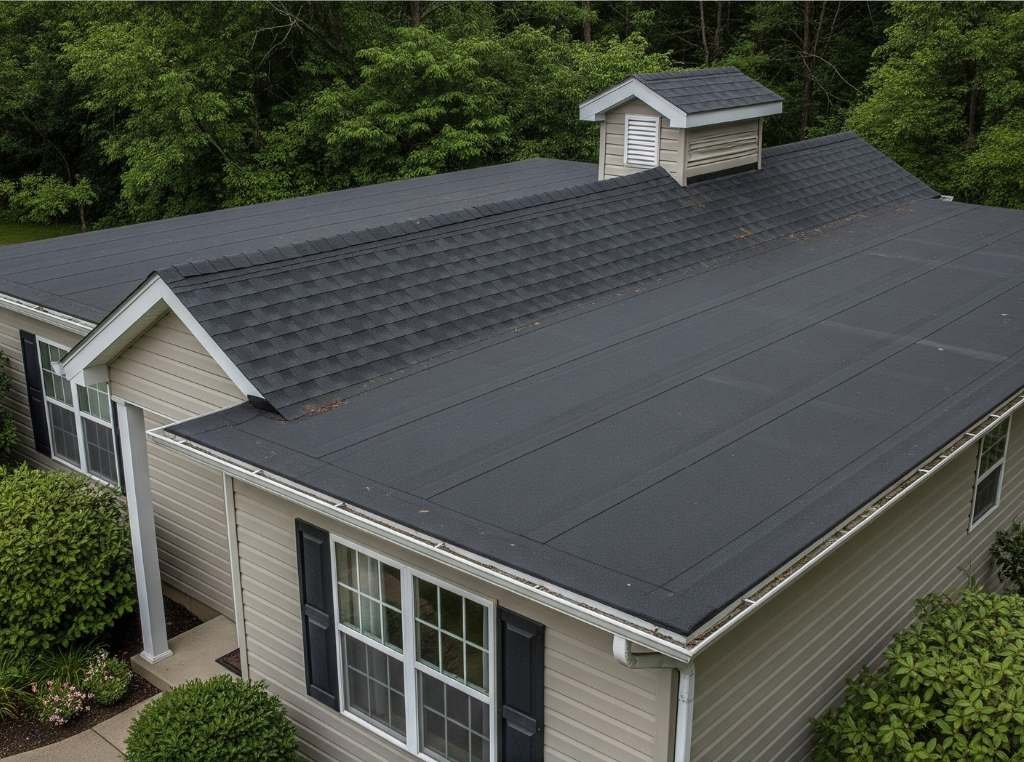
What Are the Maintenance Requirements for Roll Roofing and Asphalt Shingles?
Roof maintenance is essential to its longevity and performance. Understanding the maintenance needs of roll roofing vs asphalt shingles can help you keep your roof in top shape. Below is a comparison of the maintenance requirements for both types:
| Maintenance Factor | Roll Roofing | Asphalt Shingles |
| Cleaning | Requires occasional cleaning of debris, especially around edges. | Needs regular cleaning to prevent moss, algae, and debris buildup. |
| Inspection | Should be inspected every 1-2 years for cracks or leaks. | Inspections should be done annually, focusing on shingles’ condition. |
| Repairs | Repairs are easier and less costly but may need to be done more frequently. | Requires more attention, especially for broken or missing shingles. |
| Weather Resistance | May require more frequent maintenance after extreme weather. | Asphalt Shingles can resist harsh weather, but repair is needed if damaged. |
| Lifespan Maintenance | Regular maintenance can extend its lifespan by a few years. | Less frequent maintenance is needed, but proper care extends its lifespan. |
| Sealing and Re-coating | Needs re-coating every 5-7 years to maintain waterproofing. | Minimal re-coating needed; some shingles may require a sealant over time. |
Variation of Style
While both roll roofing and asphalt shingles serve their purpose, they offer different aesthetic options. Below are the available styles for each type:
Roll Roofing:
- Flat, Simple Design: Roll roofing provides a smooth, uniform appearance, ideal for flat roofs. Its simplicity makes it a go-to for industrial or low-cost buildings.
- Minimal Color Options: Typically, roll roofing is available in black, gray, or white. These basic colors limit aesthetic options but still suit various styles.
- Lack of Texture or Depth: Roll roofing lacks the texture that shingles provide, which may make it less appealing for residential homes. The smooth surface tends to be less visually interesting.
- Practical for Smaller Roofs: Roll roofing is a preferred option for smaller roofs, such as sheds or garages. It’s simple and efficient for small-scale applications.
- Easier to Repair: Since roll roofing uses larger sheets, repairing any issues is quicker. It’s perfect for those who prefer a low-maintenance, uniform look.
Asphalt Shingles:
- Variety of Textures: Asphalt shingles are available in a range of textures, from smooth to rough. It provides more aesthetic variety. This allows homeowners to select a style that complements their house.
- Wide Range of Colors: Asphalt shingles offer a diverse range of color choices, including shades of brown, red, green, and blue. This flexibility allows for easy customization.
- Traditional or Modern Appeal: Asphalt shingles can give both traditional homes and modern designs a finished, polished look. They are versatile in style, which enhances curb appeal.
- Dimensional Shingles: Some asphalt shingles are designed with a layered, 3D effect, which adds depth and richness to the roof. This style is popular in high-end residential homes.
- Impact-Resistant Designs: Some asphalt shingles are designed for increased impact resistance, which provides better protection against hail or debris. These shingles often have a more durable and attractive look.
What Is the Environmental Impact of Roll Roofing and Asphalt Shingles in Brooklyn?
The environmental impact of roofing materials is a crucial consideration, particularly in areas like Brooklyn, where weather conditions are highly variable. Roll Roofing is often made from petroleum-based products, which can contribute to environmental pollution during production. Asphalt shingles, while more durable, also contain petroleum-based materials, but they last longer. It reduces the need for frequent replacements.
However, both roofing options may be difficult to recycle, which leads to increased waste. Homeowners concerned about sustainability might consider alternatives, such as recycled shingles or eco-friendly roofing materials, which offer less environmental impact.
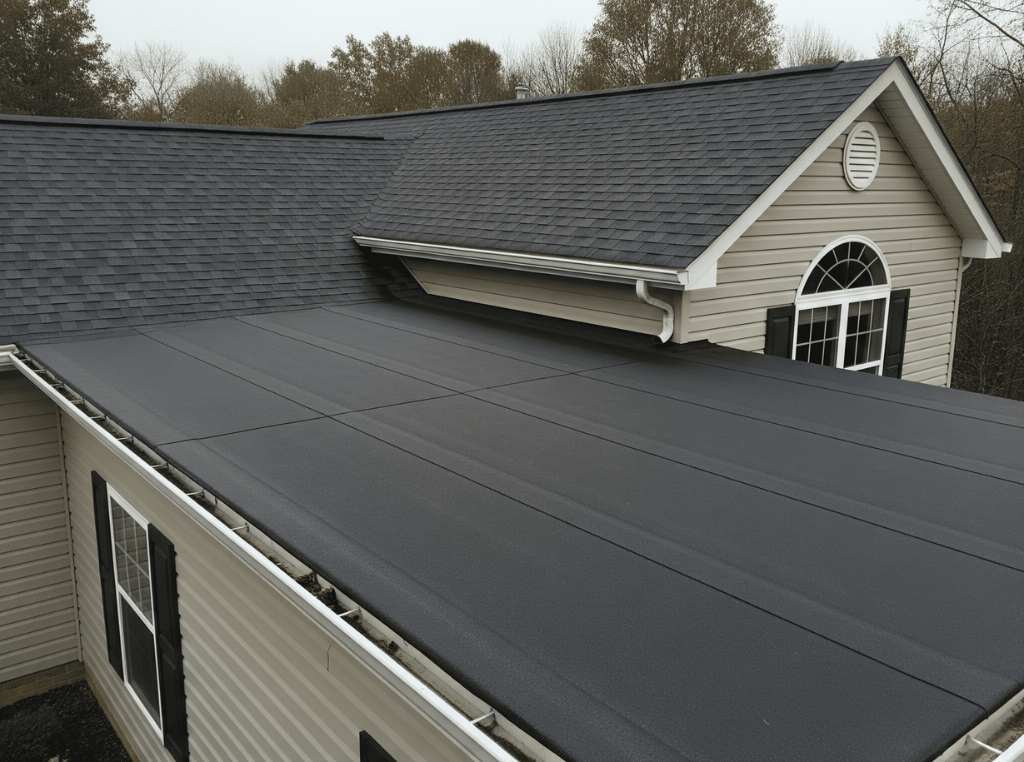
How Does the Repair Process Differ for Roll Roofing vs Asphalt Shingles?
Repairs are inevitable, but the process for roll roofing and asphalt shingles varies in complexity and cost. Here’s a comparison of the repair process for each:
| Repair Factor | Roll Roofing | Asphalt Shingles |
| Ease of Repair | Repairs are relatively easy and inexpensive. | Repairing shingles can be more labor-intensive and costly. |
| Material Replacement | Entire sections can be replaced quickly. | Individual shingles are replaced, requiring a more detailed approach. |
| Tools Required | Basic tools such as a utility knife and adhesive. | Specialized tools are needed to lift and replace shingles. |
| Duration of Repair | Repairs can be completed in a few hours. | Shingle repairs may take a full day, depending on roof size. |
| Cost of Repair | More affordable due to the simplicity of the material. | Higher repair costs due to labor and material complexities. |
| Weather Impact | May require more frequent repairs after severe weather. | Asphalt Shingles hold up well but may need repairs after extreme conditions. |
What Is the Difference in the Insulation Process?
The insulation process for roll roofing and asphalt shingles differs in terms of energy efficiency and installation complexity. Here’s a breakdown of how each performs:
Roll Roofing:
- Requires Additional Insulation: Roll roofing usually needs extra insulation beneath it for optimal energy efficiency. Without it, homes may lose heat during winter.
- No Built-in Insulation: The material itself doesn’t offer much insulation, so it’s essential to use additional layers for better performance.
- Less Effective for Insulation: Roll roofing does not provide much resistance to heat transfer, which makes it less energy-efficient during the summer months.
- Insulation Can Be Installed Easily: Adding insulation under roll roofing is a straightforward process and relatively affordable.
- Ideal for Small Areas:Roll roofing is commonly used in smaller, less climate-sensitive structures. It reduces the concern about insulation.
Asphalt Shingles:
- Built-in Insulation Properties: Asphalt shingles naturally provide better insulation. It helps keep homes warmer in winter and cooler in summer.
- Reflective Granules for Energy Efficiency: Many asphalt shingles feature reflective granules that help reduce heat absorption, which makes homes more energy-efficient.
- Multiple Layers Enhance Insulation: The layered design of asphalt shingles offers better insulation than roll roofing, especially in cold climates.
- Improved Performance with Insulation: If extra insulation is needed, it’s easy to install alongside asphalt shingles, enhancing overall energy performance.
- Better Heat Retention: Asphalt shingles are better at retaining heat during winter. It makes them more effective in Brooklyn’s cold season.
What Warranty Options Are Available for Roll Roofing and Asphalt Shingles?
Both roll roofing and asphalt shingles come with warranties, though they differ in coverage and duration. Roll roofing typically offers a shorter warranty period, typically ranging from 5 to 10 years. Asphalt shingles, however, often come with longer warranties, ranging from 20 to 30 years. Usually, lifespan depends on the brand and quality.
Pro Tip
SR General Construction offers a 12-year warranty on new installations. They provide 24/7 service and are a certified construction company, which ensures peace of mind for homeowners in Brooklyn.
Pros and Cons of Roll Roofing
A detailed understanding of the pros and cons helps you to know the strengths and limits before you spend money. A roof that suits the building and climate lasts longer and requires fewer repairs. Clear pros and cons also guide you on when to call a pro and when a simple patch will do.
Advantages of Roll Roofing
- Lower upfront cost: Roll roofing often costs less per square foot than many flat-roof systems. That helps on tight budgets or small projects. You can target upgrades only where they matter most.
- Fast installation: Rolls cover wide areas in fewer passes. That cuts time on-site for small roofs. Less time often means less disruption at home.
- Works on low slopes: It suits roofs that are too flat for shingles. Lapped seams guide water toward drains and edges. The result is simple coverage for porches, sheds, and small additions.
- Lightweight system: The sheets add little load to the structure. That helps older decks with limited capacity. It also eases transport up ladders and across tight sites.
- Simple repair process: Many fixes use basic tools and small patches. You can clean, prime, and lap a patch over a slit or blister. Good prep yields a neat, tight seal.
- Multiple install methods: You can choose self-adhered sheets, cold adhesive, or torch-applied systems (pro only). This flexibility fits many job sites and budgets. It also allows you to avoid open flames when necessary.
- Cool color options: Light or white granules reflect sunlight and lower roof temps. That helps with comfort on top floors in summer. It can also support local energy goals.
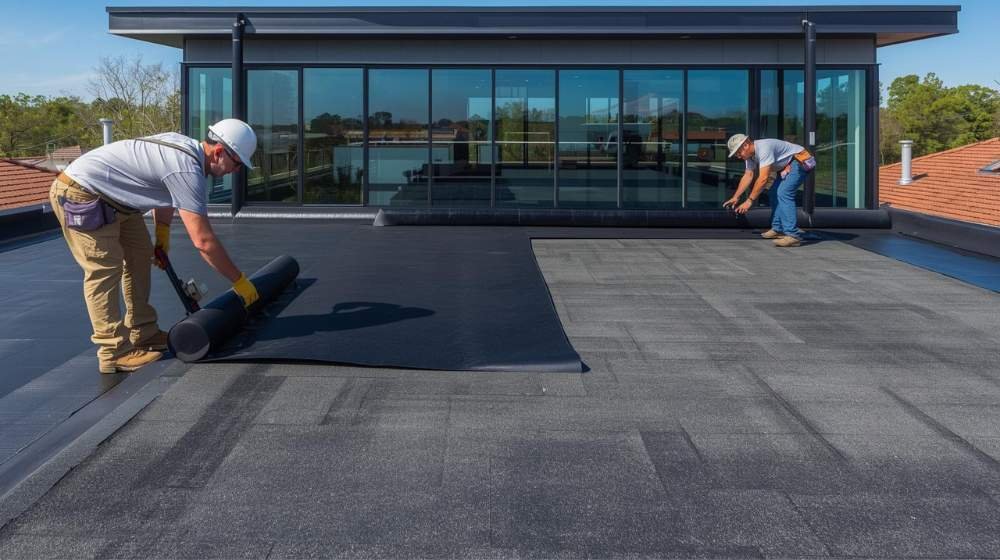
Limitations of Roll Roofing
- Shorter service life than premium membranes: Basic mineral-surfaced rolls often last fewer years than systems like modified bitumen multi-ply or single-ply. Sun and temperature swings can cause the surface to age. Plan for more frequent replacement on busy roofs.
- Limited curb appeal: Color and texture choices are fewer than those available for shingles, tile, or metal. The look suits utility areas more than showpieces. Front-facing roofs may require a different material.
- Seam and drainage sensitivity: Laps and edges need clean, dry prep and firm pressure. Poor slope or clogged outlets can cause water to accumulate and stress seams. Good drainage design protects the field and the joints.
- Not ideal for complex roofs: Many penetrations, tight corners, or heavy foot traffic raise risk. More details mean more places where leaks can occur. In those cases, a tougher multi-ply or single-ply system may serve better.
- Product and code limits: Some rolls need a minimum slope and specific fastener spacing. Torch work requires trained crews and strict safety protocols. Always check the data sheet and local rules before you start.
The Advantages and Limitations of Asphalt Shingles
Asphalt shingles are a popular choice for homeowners due to their affordability and reliability. They come with a variety of benefits but also have a few limitations. In this section, we will explore the advantages and limitations of asphalt shingles to help you make an informed decision for your home.
Advantages of Asphalt Shingles
- Affordable: Asphalt shingles are one of the most cost-effective roofing options.
They offer great value for money, especially when compared to materials like slate or metal. - Easy to Install: Asphalt shingles are simple to install, which makes them a popular choice for both homeowners and contractors. The installation process is quick and doesn’t require specialized skills, reducing labor costs.
- Durable: Asphalt shingles are built to tackle harsh weather conditions. They are designed to handle wind, rain, and snow, which makes them a good fit for areas like Brooklyn.
- Variety of Styles: Asphalt shingles are available in a wide range of colors and styles. This allows homeowners to select shingles that complement the style and character of their home.
- Low Maintenance: Asphalt shingles require little maintenance. Routine inspections are usually enough to keep them in good condition for years.
- Fire Resistant: Many asphalt shingles are treated to be fire-resistant.
This adds an extra layer of protection, particularly in dry or fire-prone areas. - Energy-Efficient Options: Some asphalt shingles are designed with reflective coatings that help reduce energy consumption. These shingles can help reduce cooling costs by reflecting sunlight away from your home.
Limitations of Asphalt Shingles
- Shorter Lifespan: Asphalt shingles generally last 15 to 30 years. This is shorter than other materials, such as slate or metal, which can last 50 years or more.
- Susceptible to Extreme Weather: Although durable, asphalt shingles can be damaged by extreme weather conditions. Hailstorms and strong winds can cause shingles to crack or blow off.
- Environmental Impact: Asphalt shingles are made from petroleum-based products. This raises environmental concerns, especially since they are not easily recyclable.
- Vulnerable to Algae Growth: In humid environments, asphalt shingles can develop algae stains. This affects the appearance of the roof and may require cleaning to maintain its look.
- Potential for Cracking: Over time, asphalt shingles can become brittle and crack. This is often due to UV exposure, temperature changes, or improper installation.
- Not Ideal for Flat Roofs: Asphalt shingles are better suited for sloped roofs. On flat roofs, they may not perform as effectively, as water can pool on the surface.
Which roofing option is the most suitable for Brooklyn’s weather?
For Brooklyn’s weather, asphalt shingles are the most suitable roofing option. They offer better durability and insulation, which makes them ideal for the city’s cold winters and hot summers. Their multi-layer design and granulated surface also provide extra protection against harsh weather conditions, including heavy rain, snow, and wind.
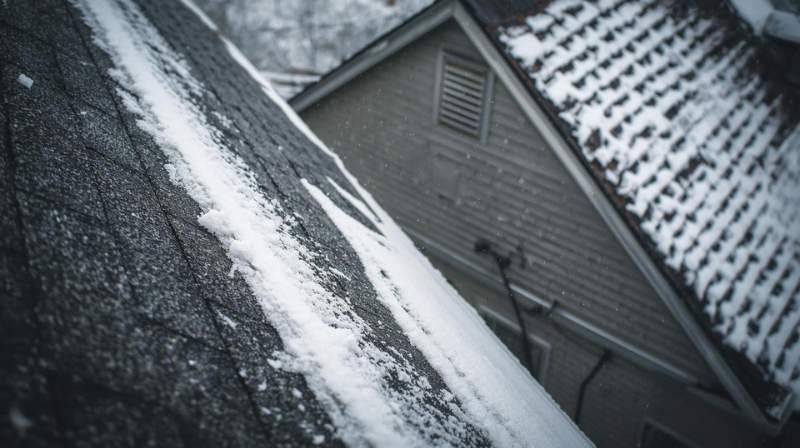
Why should you choose a professional roofing contractor?
Are you looking for an expert roofing contractor in Brooklyn, NYC? SR General Construction has you covered! Our business is located at 8807 Avenue B, Brooklyn, NY 11236, United States, in the Canarsie area.
We proudly serve all areas of Brooklyn with high-quality, durable roofing solutions. From new installations to repairs and maintenance, we provide the best service at affordable prices. Contact us and experience why we’re Brooklyn’s roofing experts!
FAQ
1. How do asphalt shingles differ from roll roofing?
Asphalt shingles are separate pieces that overlap and are made for sloped roofs. They last longer and look better. On the other hand, roll roofing is a single layer of material that works best on flat or low-sloped roofs.
2. Which roofing material lasts longer?
Asphalt shingles typically last between 20 and 30 years due to their multi-layer design. Roll roofing has a shorter lifespan, usually around 10 to 15 years.
3. Which roofing option is more affordable?
Roll roofing is more affordable, with costs ranging from $1.50 to $2.50 per square foot. Asphalt shingles are more expensive, typically ranging from $3.50 to $5.50 per square foot.
4. Is professional installation recommended for asphalt shingles?
Professional installation is recommended for asphalt shingles due to the need for precision and skill. A roofing expert ensures that the shingles are installed correctly to prevent issues like leaks.
5. Is roll roofing suitable for Brooklyn’s climate?
Roll roofing is not ideal for Brooklyn’s harsh winters and humid summers due to its shorter lifespan. It is better suited for smaller structures that don’t require heavy-duty protection.
6. Why are asphalt shingles better for Brooklyn?
Asphalt shingles provide better durability, insulation, and weather resistance, which makes them more suitable for Brooklyn’s varying climate. They handle both hot summers and cold winters effectively.
